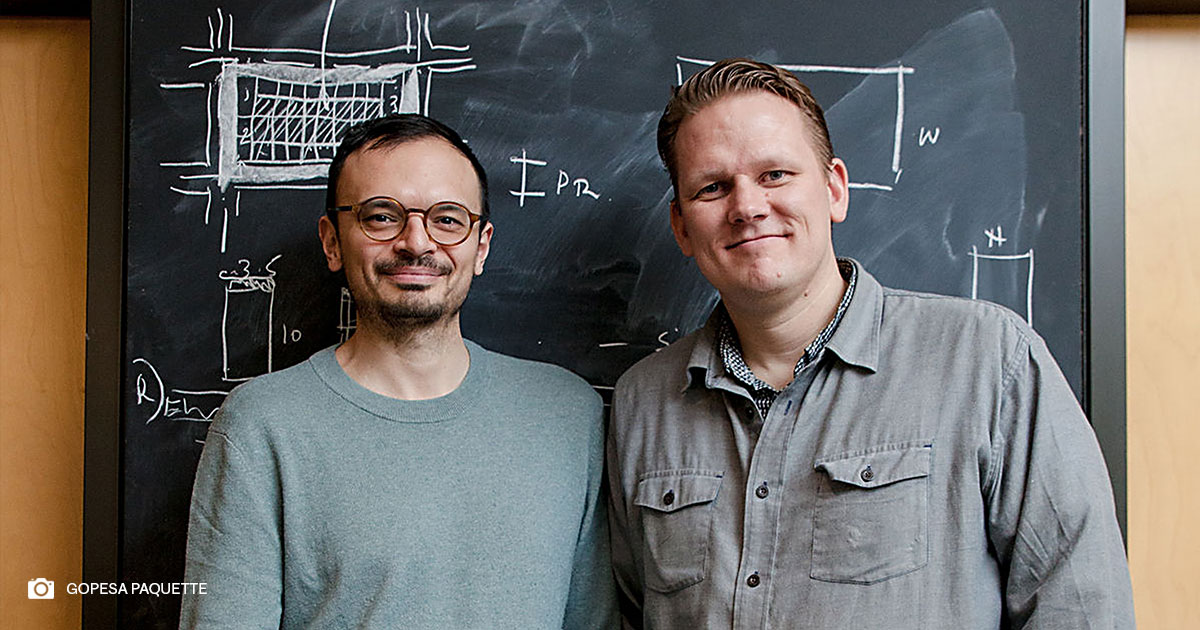According to Prof.Kiel Moe, the Gerald Sheff Chair in Architecture, Quebec can become a model for a sustainable society by taking a closer look at two of its key resources—wood and water.
Prof. Kiel Moe wants to help people understand the way energy actually works. The inaugural Gerald Sheff Chair in Architecture (since 2005, the Sheff Chair was for a visiting academic, but was converted to a permanent Chair in 2018) hopes to rein in the use of terms like “sustainability” and “energy-efficiency” by challenging how most architects and builders think about environmental technology and design.
“There’s a lot of confusion about energy and what energy is,” Moe says from his office in MacDonald-Harrington building. “We can never achieve sustainable cities or living if we keep thinking of it through the lens of ‘petroleum’ or ‘not petroleum.’ Energy these days almost exclusively refers to fuel, and to fuel-centric thinking, which is a neo-liberal, commodity-chain way of thinking. All energy is renewable – what we need is a much more systemic understanding of it.”
Everything Counts

As a student at the University of Cincinnati, the University of Virginia, and then the Harvard Graduate School of Design, Moe believed there were flaws in the pedagogy and practices surrounding architectural and thermodynamic theory, and decided to focus on reconceptualizing the idea of energy. After teaching at schools across the United States Moe decided to move to Quebec for its promising research potential and abundance of natural energy resources—forestry and hydroelectricity in particular: “With those two things, you can keep civilization going pretty darn well,” he says.
Moe’s work intends to undo the damage done by the globalization of supply-chain industries, which have long been the foundation of contemporary architecture and construction. As a result of globalization of the supply-chain, the primary energy costs of extracting materials, processing them, and transporting them around the world can be greater than the energy needed to operate a building. Moe describes his approach as ‘construction ecology,’ in which energy has economic, environmental, and ethical components.
“It’s only when you’ve mapped out the whole ecology of materials—when we know the conditions of workers in the Chilean mine from which the copper is coming, or the factory in Malaysia that is making the plastic—that we can actually have a proper conversation about ethics. It is a social science approach to ecological economic exchange: there’s a reason why Chile stays poor and New York City gets rich, even though NYC is full of copper from Chile. It’s a very complex subject, but I think it’s absolutely necessary if you are serious about the word ‘sustainability’. You have to take on all of that to be able to properly understand the relationships.”
This type of ‘Supply-Chain Activism’ runs counter to what many academic institutions have upheld within the culture of Modernist architecture, which according to Moe has been very good at making materials do one job and one job only. “But if, for example, we can get a piece of wood to be an insulator in addition to being a structure of a home, we can also restructure our forests and our rural economies—we’re thinking how to conserve at every point of the supply chain.”
A Quebec Case Study
Moe and his research partner Associate Professor Salmaan Craig, are currently bringing this philosophy to bear on a multi-scale project in an Indigenous community of Northern Quebec. The pair will be doing everything from small design-build projects, to larger neighbourhoods and regional parks, from shore-line resilience, to dealing with issues of climate-change.

The duo met at a conference in 2014, while they were still both at Harvard. Their current collaboration mirrors the Faculty of Engineering’s approach to the engineer-architect relationship, a more “Swiss-German polytechnic model” which encourages cross-pollination between engineers and architects. In fact, Craig is trained as an engineer, but is teaching at the School of Architecture, a novel concept, says Moe. Their combined methods are pragmatic and simple, but can ultimately reshape urbanization processes to accommodate the planet’s drastically-shifting environmental circumstances. Thanks to Gerald Sheff’s generosity, which created the new chair position, Moe and Craig’s future collaborations will place the School of Architecture at the vanguard of sustainability and activism.
